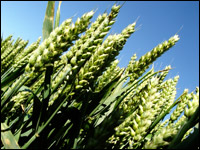It was supposed to take until 2080 for food prices to double. Sure, climate change can make arable land into irrigation-hungry desert, and increase the likelihood of crop-destroying severe weather (and wildfires). But ironically, increased carbon dioxide also helps plants grow, so this was all supposed to be under control for the foreseeable future. Turns out: Nope. Prices had already doubled or even tripled for some staples before the recession, and they're on their way back up. World hunger is poised to increase at a speed not seen in decades. And climate change is to blame.
Changes in weather have a big effect on crops even when they're not as showy as a deadly snowstorm or hurricane. Rain and heat at the wrong time can mean water shortages or flash floods. Changes in weather conditions have also led to new pest and disease threats. The growing seasons have gone all cockeyed: There's too much rain in the dry season, too much dryness in the rainy season, and not enough cold season at all. Meanwhile, plants do grow a little better with extra CO2, but not as much as previously thought — and not enough to offset all the other negative effects of climate change.
All this means that food prices are projected to double again, from already high levels, by 2030. And as many as 940 million people in the world went hungry last year. In the mid-90s, that figure had been muscled down to 800 million.
So, this is awesome! Are we totally doomed? Not yet, apparently:
Agronomists emphasize that the situation is far from hopeless. Examples are already available, from the deserts of Mexico to the rice paddies of India, to show that it may be possible to make agriculture more productive and more resilient in the face of climate change. Farmers have achieved huge gains in output in the past, and rising prices are a powerful incentive to do so again.
But this will take new farming techniques and new kinds of crops (like flood-tolerant rice), and that takes research funding and time. Alternately, I hear great things about this stuff called "Soylent Green" …



